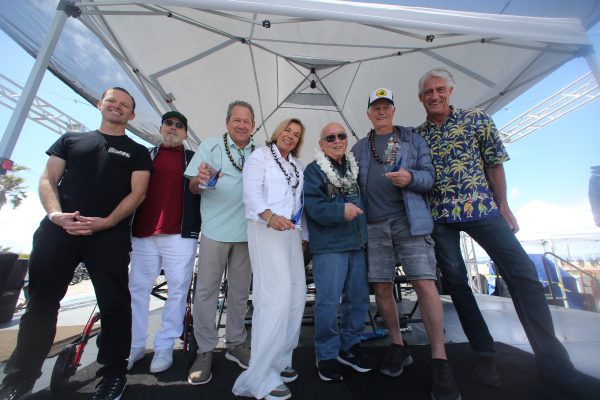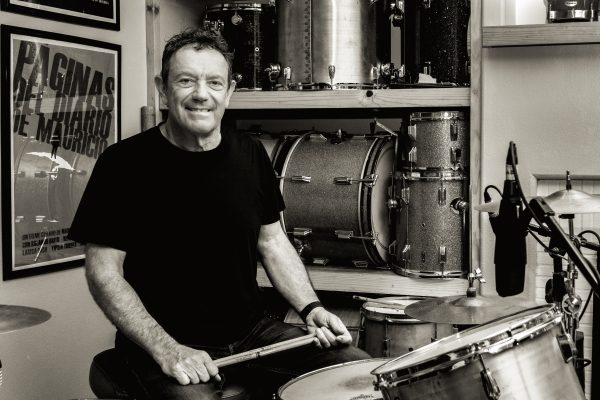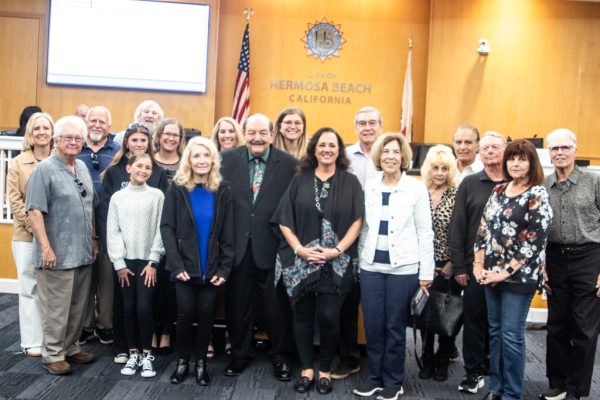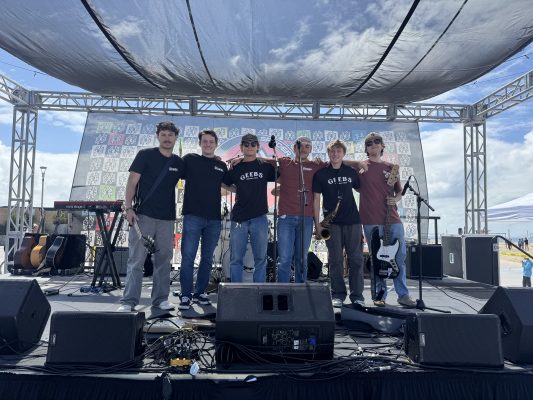
For decades Jack Hoy and his neighbors watched Hermosa go by from low-backed chairs outside the funky 1950s-built apartment building they called home, just blocks from the beach and around the corner from downtown.

Nearby, the buildings of a commercial district revolved again and again through the throes of changing occupancy, renovations, re-paintings, decay and renewal. Down the block, civic pooh-bahs fought tooth and claw over a swelling nightlife scene. Right across the alley, one of Hermosa’s new tattoo parlors became a lightning rod for long argument and courthouse briefs.
It all seemed miles away from the little strip of patio upon which Hoy and a few others lounged and slowly aged. A time-lapse video would have shown no change on the patio, save a slow graying of heads and beards.
It is the home that time forgot. Residents have stayed put for decades. Rents are low and life is good. And his neighbors have had Jack to thank for that.
Hoy, a retired aerospace engineer, bought the white, two-story building with 13 irregularly shaped and sized units, on the corner of Eighth Street and Manhattan Avenue, in the mid-1970s, and did not allow the market price to dictate what he charged for lodging.
He simply lived the good life alongside his neighbor-tenants, riding his bicycle, playing volleyball and chess, and donning a warm red jacket once a year to fish for salmon and halibut in Alaska, bringing back his haul for a fish fry in the apartments’ courtyard.
Time stood still until a couple of years ago, when a cancer in his neck began to spread, taking his health as it went. On Friday Hoy passed away, at home, in the bed of his upstairs unit facing the ocean, at age 73. Services had not been set.
Ownership of the building passed to siblings of Hoy in Midwestern states. Tenants do not know what changes might come; they simply have received a notice that they will be offered month-to-month leases.

Friends and neighbors recalled Hoy as a generous and strong willed man with a quiet sense of humor.
“He was the greatest,” said apartment dweller Virginia Douglas, who has been living in her deceptively spacious upstairs unit since 1963, about a decade before Hoy bought the building. At first she knew Hoy as a tenant in another apartment building, which she and her husband John managed.
Hoy had been waiting for a rental unit to open up in the building that time forgot, and when it did, he moved in, and immediately began considering a purchase of the building, using money from the sale of his old house for a down payment.
“Lo and behold, he bought it,” said Douglas, who raised a son and daughter in the apartment with her husband, before he died 12 years ago.
“We loved it here, the kids loved the beach,” she said.

Douglas and neighbor Robi Hutas, a photographer who has lived in the building since 1964, praised Hoy’s casual rent control.
“I think the rent went up when someone moved out,” Douglas said. “But no one ever moved.”
“It’s like a family here,” Hutas said.
Most of the tenants enjoy garage parking – a seaside premium – and Hoy made improvements to apartments willy-nilly. Laurie Bates, a three-year tenant who pays “very low” rent similar to the long-timers, has a bathroom that is mostly redone, except for the 1960s linoleum floor. She described Hoy’s own digs as a microcosm of the building.
“His apartment had three colors of carpet,” she said. “He was so cute.”

After nearly four sun-splashed decades, Hoy’s health began to fail.
In an August 2009 email to friends, Hoy wrote that surgeons were about to remove a four-to-seven-inch circle of skin of “varying depth” from around his right ear, taking the ear with it, and cover the spot with skin from one of his legs.
“The result of this is I will be able to go to costume parties as van Gogh,” he quipped.
He would have no right eardrum or aural canal, so he would be deaf on that side, he wrote.
His email signature included the latitude and longitude of his apartment building.
Hoy did lose his ear and much of his face, but battled on.
“He was such a strong guy. He fought and fought. You couldn’t find a better guy for that,” Hutas said.

The fishing trips to Alaska were over, but Hoy gathered himself for one last hurrah.
“In March he made a trip to Australia and New Zealand. He wanted to go, and the doctor told him to take the trip,”Douglas said. “It was his last trip.”
Hoy arranged to die at home, with the comforts of beloved surroundings and a 55-inch Samsung TV. Two hospice nurses watched over him in shifts.
“People visited him left and right. You’d think there was a cocktail party over there,”Douglas said.
Toward the end Hoy became unable to swallow or to speak, and his weight finally dwindled to about 90 pounds.
“When they carried him out one of the hospice nurses was waving, ‘Goodbye Jack,’” Douglas said.
“He was a great guy, man,” said Hutas.
They were Jacked — in a good way
Jack Hoy’s benefactors include men in funky corner apartments, a friend who was more like an adopted daughter and a neighbor who leaned on his unfailing helpfulness. They tell tales of the TRW engineer, shoeless in the office with his stomach showing through a holey T-shirt, and a Samaritan landlord who rarely had a vacancy unless a tenant died.
Tattered engineer
Adriana Whitney met Hoy two decades ago at TRW, where she worked as a data base and projects manager. The shabbily dressed Hoy appeared to be a helpful pauper, voluntarily popping into her section to fix computers so the workers wouldn’t have to wait for the company to send someone.
“He would always wear a T-shirt, he liked bright T-shirts,” Whitney said. “He would never wear shoes, he always wore sandals, and his socks and T-shirts had holes in them. And it was a professional environment at TRW.

“There was this bright orange T-shirt, it was two sizes too small for him, and he was still wearing it. You could see his stomach because there was a hole, high in the middle. I knew that Jack was divorced, and I said, ‘Oh my God, he must have lost all his money when his wife divorced him.’
“I said, ‘You know what, I’m going to take him out and find him some clothes.’ I thought he didn’t have any money. We went out – I don’t even know where – and I got him pants and a shirt. That’s how I got to know Jack. I found out later that he owned an apartment building.”
‘Feet first’
Whitney was commuting from Riverside, and wanted to move her and her mom into the beach cities.
“I asked if he had any vacancies, and he said the only way they move out is feet first,” she said. “A week later we were having lunch and he said guess what, I have a vacancy.”
In the reaping and sowing cycle of Hoy’s building, his next-door neighbor had died, and Whitney moved in.
“That’s how I got to rent the apartment right next to him. When he told me how much [the rent was], my jaw dropped. I thought it was a special price, but then I moved in and found out why nobody ever left. The rents were way below market value,” she said.
“There are people who have two bedrooms for $640 a month,” Whitney said, turning her attention to the present day. “He just told me, ‘I have enough money. I don’t need the money.’
“He didn’t spend money on himself. He was a real techie guy, but the computer he had, it took 15 minutes just to start up. Later in life, when we looked upon each other as family, I told him, it’s not going to be forever. He got more into buying computers, and some things he enjoyed a little more,” she said.
Whitney lived next to Hoy for a couple of years and then married, and now lives in Palos Verdes, but she remained close to “the next best thing to a father,” and Hoy regularly went up the hill to walk Whitney’s low-slung, sandy haired mutt, Sparky.
“He loved Sparky and Sparky loved him,” Whitney said.
After Jack got sick he underwent surgery, then radiation, then chemotherapy.
“During chemo I would see Jack on a daily basis. I would go over [to the apartments] and say. ‘Jack, what are you doing?’ He would be on top of the roof fixing someone’s antenna, he would be under someone’s sink fixing the sink. He was all tired and everything. As long as he thought he could still do it, he would be out there fixing somebody’s things,” Whitney said.
“Whoever came across his path, their life improved just knowing Jack,” she said. “He was the most giving person I ever met, and he never expected anything back from anybody.”
Corner pocket
Photographer Robi Hutas, 75, told a Hungarian-accented tale of kindness and Murphy beds as he recounted how he has hunkered in a funky downstairs corner unit for the past 47 years.
“Really, listen — I have been there since 1964, right? I have never asked for anything in 47 years. I painted the place. I put the carpet in,” he said. “At the end, [Hoy] came in and did something with the bathroom. But you know why?”
Seven or eight years ago a flood came from the apartment upstairs, making its way through holes in the ceiling for electrical wiring for overhead lights.
“The guy left and the toilet overflowed, or something,” Hutas said. “It leaked down through the light bulbs, can you believe it? You come home and you open the door, and water runs out of the building.”
Hutas still pays low, low rent with occasional increases so small that “you could call it zero, basically.”
With ownership of the apartments going to Hoy’s out-of-state siblings, Hutas and his neighbors do not know what the future will bring.
“I have no idea whatsoever. I have no idea at all. I don’t know anything about what is going to happen, and it’s kind of scary,” Hutas said.
He said he was mailed a rental application, the type of document he had not dealt with in at least a half-century.
“They asked me my name, and what I earn. They asked me what rent I pay,” Hutas said, wrinkling his brow.
Hutas did not spend all 47 years in the same unit. At first he was in a different downstairs corner apartment, a small place with a Murphy bed, one of those monsters that fold up into the wall when they’re not being slept upon.
“Fifty bucks a month I paid in 1964. Is that unreal?” he said, adding that the Murphy bed seemed to consume the entire apartment when it was out of the closet.
“I hated that Murphy bed,” he said. “I slept on the couch. If you pulled it out it took everything.”
Pulling strings
Jose Medrano, 36, a Federal Express driver who trucks batteries, clothing and whatnot on a regular route to Portland,Oregon, lives in the funky little unit now, but the Murphy bed had been removed before he moved in.
Landing the apartment was a multigenerational effort that started with Medrano’s grandmother babysitting for families that lived on the upper floors in the 1990s, continued with Medrano’s Uncle Tommy talking to Hoy on Medrano’s behalf, and ended when a previous tenant died and Medrano replaced him.

Medrano moved from the San Fernando Valley into the corner unit seven years ago. He started out paying $500 a month, and in time his rent went up to $550.
He did not tempt the fates by asking why the rent was so low.
“I never knew if it was rent control, or if it was that Jack was just cool like that,” Medrano said.
“When I moved in I was working at Vons, and we were on strike,” he said. “I never could have swung this if Jack wasn’t so cool.”
The front door of Medrano’s apartment opens onto his kitchen, where the first thing a visitor sees is a refrigerator with family photos on little magnets, followed by a microwave oven with a tiki figure on top.
Past the kitchen stands his living room/bedroom, painted forest green and filled with a futon, a small couch and a big chair. A doorway leads to the bathroom, but first there is a long, strange anteroom in between, sort of unfinished bathroom lobby, which Medrano uses to store a couple of bicycles.
Before Medrano moved in, Hoy fixed up the bathroom and kitchen, which sports a neat tile countertop.
“Jack was always a great person,” Medrano said.
Women and dogs
Rich and Cindy Aylward, who live across Manhattan Avenue from Hoy’s building, met Hoy near the dawn of the 1990s and struck it off right away.
“We were friends right off the bat. Jack was a very personable personality,” Rich Aylward said.
“He was probably the most well read person I have ever known. If you asked him a question on any subject he could speak intelligently about it. And he was my go-to guy for fixing anything. He helped everybody out. He was very generous with his time and expertise,” Aylward said.
“He had a chess club that met once week at people’s homes, and I’ve met some of his chess partners, and they said he always won. He was always on. It’s a huge loss to the area.”
Hoy used to hang out in one of the garages that stood in a row on the east side of his building, reading, puttering on a workbench, playing with a computer and giving treats to passing dogs, including those being exercised by professional dog walkers.
“Dogs used to make a beeline for his garage,” Aylward said. “And as my wife said, most dog walkers are attractive women, so sometimes he might have been more interested in the other end of the leash, you know. If you brought that up he wouldn’t say anything, he would just smile.”










